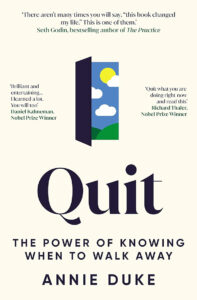 Book Review: Quit – The Power of Knowing When to Walk Away by Annie Duke
Book Review: Quit – The Power of Knowing When to Walk Away by Annie Duke
Reviewed by Canon Mike D Williams
Quitting is an underrated virtue. That is the argument of this book. Too often persistence is thought better than quitting. Yet knowing when to quit might open new opportunities – it might even save your life.
Climbing Everest provides an excellent example. Climbers must set turnaround times. If they have not reached their planned objective, they need to quit and return. If you are only a few hours from the summit the temptation is to keep going. Yet to do so can be fatal.
Quitting is a decision-making tool – it is a skill that can be learnt. Yet often we get caught up in the activity and keep going despite the changing context. New information is critical feedback. There may be new facts. The costs of the project have doubled, the weather on the mountain has closed in. Do you keep going? It is about decision making under circumstances of uncertainty. Quitting requires being okay with not knowing what might have been.
Annie Duke has an interesting background that equips her to write this book. On path to be an academic, ill health intervened so she needed to find a way to earn money. She followed her brother and became a professional poker player. She learnt when to quit, cut her losses and come back another day.
There are many examples in the book from when taxi drivers should quit looking for customers on quiet days to building high speed railways in California. The story of escalating commitment is a common theme. You keep going because you have already invested time, effort or money. It would be a waste to quit. A successful grocery store business that became very successful, then started to lose out to competitors. Rather than quitting the owner poured all his wealth into subsidising his losses until he went bankrupt. Sticking to a course of action because of previous commitment is a common tendency.
It is linked to the idea of sunk costs and the fear of waste. We often give more weight to the downside of quitting rather than the downside of persisting. Establishing quitting criteria before you start can help rather than being caught up in the emotions of the moment. Set benchmarks for what success looks like. Climbers set turnaround times before they start to avoid the temptation in the moment to keep going.
The lessons drawn from the many examples apply to all aspects of life, not just big projects or life changing decisions. The book uses lots of stories with a nod to the theories of behaviour that explain why we find quitting so hard. The biggest lesson for me is that learning to quit can be positive. In the case of climbers on Everest – they live to climb another day.